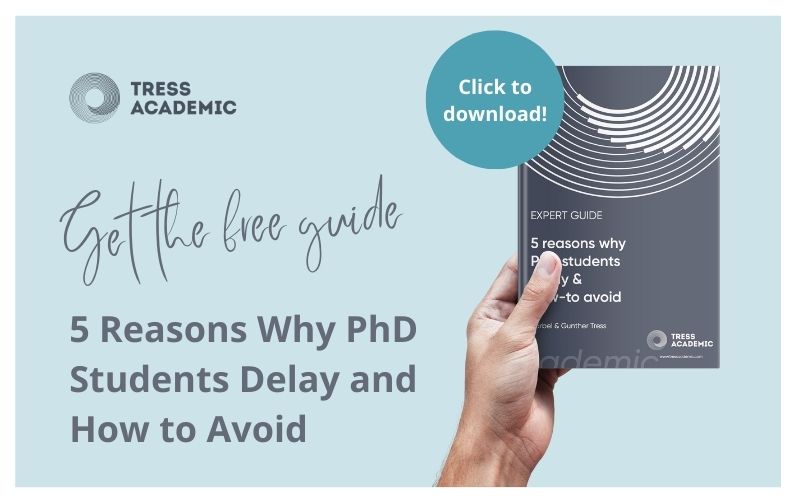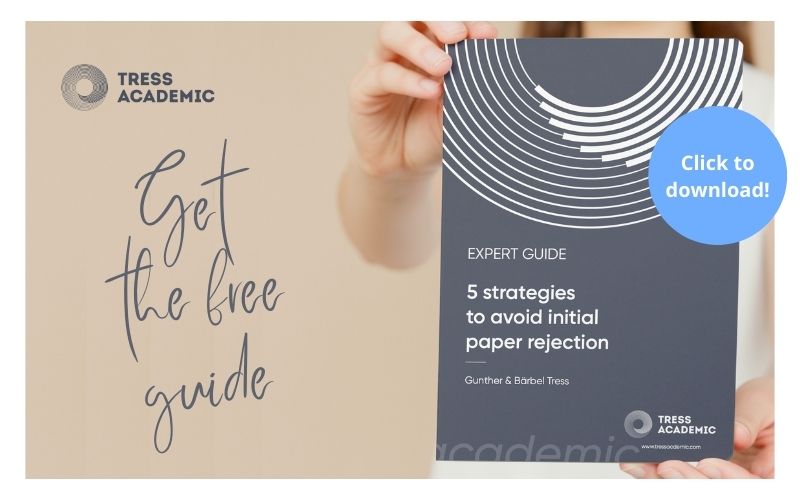Are you planning to write a PhD dissertation that is based on peer-reviewed publications? If so, consider these 5 tips to help you to avoid common pitfalls. An article-based dissertation can gives you the opportunity to make your research known to an international audience early in your career. But it comes with a few strings attached and a couple of hurdles to overcome! With our suggestions you’ll be able to take it all in your stride!
Most universities today offer two options for the submission of a PhD dissertation or thesis: You can write a monograph or an article-based dissertation.
The article-based PhD dissertation consists of a string of scholarly articles, some or all of which have to be accepted or published by the time you submit your dissertation. The peer-reviewed papers included in an article-based dissertation have to originate from your PhD project. We’ve outlined the differences between both types as well as the pros and cons in our previous SMART ACADEMICS blog-post #6: Dissertation dilemma? Hand in a monograph or papers? And FYI: the article-based dissertation is also called a manuscript-based or cumulative dissertation.
In many subject areas, particularly in the natural sciences, life sciences, and empirical social sciences, the article-based dissertation is more common than the traditional way of writing the thesis as a monograph. This is why we want to outline 5 critical issues that you should be aware of when planning to write and submit an article-based dissertation. All of these are easily avoided if you know them from the outset, but tricky to remedy if you’ve not considered them. So give yourself a headstart to planning your cumulative dissertation the right way.
Tip #1: Decide early-on
From discussions with PhD candidates in our PhD and publishing courses, we know that some students work with the strategy to “just wing-it” and see if they manage to write a cumulative dissertation, and if not, they’ll opt for the monograph as a kind of fall-back option. They also seem to think that dissertation writing is a task that is only tackled towards the end of the PhD when everything else is done. The creed is: first do your research, then write it up!
While this common belief is never a good strategy, it’s likely lethal for achieving a cumulative dissertation. Both types of dissertations are fundamentally different in their structure and how they are written. How you organise the writing process is very different, and so is the writing-style. See the SMART ACADEMICS blog-post #6: Dissertation dilemma? Hand in a monograph or papers? for more detail.
We suggest you get informed about the advantages and disadvantages of both types, what is common in your discipline, and what is the best choice given your personal circumstances, writing and publishing skills, and career plans. Then make that decision early on and plan your project–aka your studies–with this end-product in mind.

Tip #2: Clarify university requirements
When we ask our PhD candidates what they need to submit as a cumulative dissertation, they often come up with a vague ‘3 papers I guess’-answer. That is not good enough! Figure out exactly what you have to submit as an article-based dissertation at your university in your faculty for your exact discipline. Why? Because many universities do not have one set of rules that apply to all subject areas, but have different regulations for different faculties or individual disciplines.
While one university may ask for 2 published papers, another may ask for 4 or 5. But not only does the number of included peer-reviewed papers vary, there are often further specifications regarding the
- publishing status of the papers
- authorship
- review articles/meta-analysis
The regulations of your university may e.g. ask you to include 3 peer-reviewed publications, 2 of which have to be published by the time you hand in your dissertation. In addition, you need to be first-author of 2 papers and only one paper can consist of a meta-analysis. There are also regulations which require you to be the sole author for one paper, or exempt your main-supervisor from being a co-author and so on. You see, the devil’s in the details. You can navigate this for sure, but you need to know! So don’t rely on hearsay, not even if it’s your supervisor. You want to see the regulations for yourself and see what’s written there in black-and-white. Here are two random links specifying requirements for an article-based thesis from one German and one Canadian university, just so you get an idea:
- McGill University, CA, Manuscript-Based (Article-Based) Theses.
- University of Jena, DE, Faculty of Chemistry and Earth Sciences, 2018: Implementing provisions for cumulative doctoral theses
But please check for yourself and see if the university/faculty where you are enrolled has similar requirements.

Tip #3: Identify paper topics
The identification of potential topics for your individual papers is a strategic move to avoid problems (e.g. paper rejection), save time, and increase the quality of your thesis.
In the case of a cumulative dissertation, you still need an overall topic which binds the papers together in a logical sequence. Plus, you have to write a substantial introduction, method section, and overall discussion and conclusion. So no, you can’t write 3 papers from 3 unrelated experiments and then patch it together as a PhD thesis. Think carefully about the overall theme of your thesis before deciding on individual paper topics.
While you can report on nearly everything you did in a monograph, for the article-based thesis, you have to decide strategically on aspects of your work that are the most original, novel, and outstanding. These will have the highest chance of passing the review process of an international journal.
If you or your supervisor are great strategists, you’ll design your experiments or field-work in a way that results in the required number of papers. Collaborations can be used strategically so they result in co-authorship if that is an option. But the same paper cannot normally be used as part of a cumulative dissertation by two PhD candidates.
Very specific decision-making and PhD project design with a focus on the thesis requirements has its own beauty and can save you from doing a lot of unnecessary work that otherwise would not get published in the end.
See also our Small Academics Blog post #103: How to find a paper topic.
Tip #4: Consider the time-line
Nothing else will torpedo your plans for a cumulative dissertation like not considering the time-line. You need to carefully calculate time for
- Paper writing (including communicating back-and-forth with co-authors)
- Awaiting the results of the peer-review process
- Revisions after you’ve received a review-report
Knowing that it may take anywhere between 6 to 10 months from submission to acceptance (seldom quicker, sometimes slower), you have to plan out exactly when you’ll submit one paper and write the next. That is often a tight game if your PhD contract or scholarship ends after 3 or 4 years.
If you need e.g. 2 first-authored, accepted papers and a 3rd one submitted, you’ll carefully need to identify the timeline for submission of your papers (including the results you’ll present and when these have to be available) so that your PhD completion won’t be delayed because you’re still awaiting acceptance of one paper.
So surely, with such requirements, postponing paper-writing until the final year of your thesis is a no-go. Probably, it would be good to devise a publishing strategy, see our Smart Academics Blog #38: Why you need a publishing strategy.
Tip #5: Mitigate risk of paper rejection
There’s a real risk of one of your papers getting rejected by the journal to which you submit it first. So planning for that risk and having one additional paper in the pipe-line can be a good mitigation strategy. Another strategy can be to carefully select the journal you’re submitting to with regards to its impact factor. The higher the impact-factor, the higher the rejection-rate. Discuss this with your co-authors and supervisors. If they are very experienced and prolific authors, and they know that your results will be outstanding, the risk of a rejection might be slim. But if you’ve got to be the sole author and you don’t have great support in the writing process, it might be a good strategy to play it safe.
Check our Smart Academics Blog post #121: How do you prevent paper rejection?
Conclusion
You can see that there are quite a few pit-falls in the writing of a cumulative dissertation. And as you’ve seen, it’s not only the writing of papers that needs to be carefully planned. There are also some decisions to make regarding their content, timing, (co-)authorship, topics, journals etc.
Submitting an article-based dissertation with published or accepted papers can positively influence your PhD thesis assessment, since your work has already been deemed ‘acceptable’ by independent international experts in the peer-review process. Still, each assessment committee will have an independent look at the overall quality. So go for it, if you have the option, but make sure you make the crucial decisions early-on.

Resources:
- Smart Academics Blog #6: Dissertation dilemma? Hand in a monograph or papers?
- Smart Academics Blog #38: Why you need a publishing strategy
- Smart Academics Blog #62: Twenty things you should know when writing a journal paper
- Smart Academics Blog #67: Writing productivity: Write more in less time
- Small Academics Blog post #103: How to find a paper topic.
- Smart Academics Blog #111: Boost your chances of paper acceptance with these 3 tips
- Smart Academics Blog post 121: How do you prevent paper rejection?
- Hendawy, M. 2021. How to structure a cumulative dissertation: Five strategies. Elephant in the Lab.
More information
Do you want to successfully complete your PhD? If so, please sign up to receive our free guides.
Photo by Freepik
© 2022 Tress Academic
